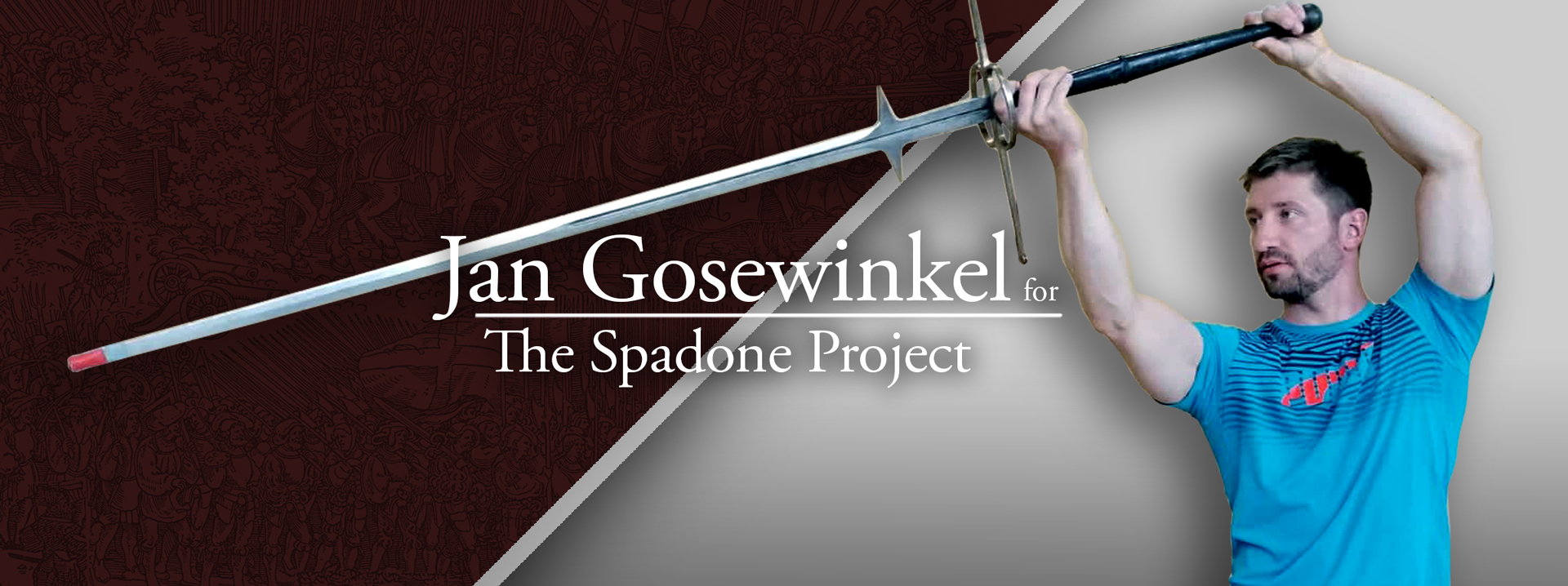Today my web guest is Jan Gosewinkel, hemaist and instructor in Bonn, Germany. He has a long experience in jiu jitsu – more than 20 years – and he has been practicing Liechtenauer tradition since 2006/2007. During the last years he has focused on Iberian montante study: his initiative is called Montantero Bonn.
He joined Drey Wunder International Montante Symposium 2018 in Bielefeld, both as an instructor and lecturer; he gathered the invitations for the other instructors and lecturers as well (Ton Puey, Heiko Grosse, Emil Andersson and Sebastian Woxell), taking part even in the event concept and developed the complete rule setting for its tournament, alongside with Drey Wunder.
We happen to exchange opinions and info about big two handed swords and Jan helped me with German sources.
Hi Jan, happy to have you here. Let’s start with the interview: it was long to put together but I have some interesting topics for you and I was looking forward to talk, are you ready?
“Hi Niccolò, the pleasure is on my side, thank you! Yes, I am ready. I’m always happy to have an opportunity to talk about big swords! But first, let me say thank you for the invitation to this interview, and especially for your Spadone Project page, which turned out to be an invaluable source of information for me since you started it.”
Great, and again, many thanks! Let’s start from the beginning but already to the main topic, to contextualize your personal path: after Liechtenauer and so so many years of jiu jitsu, why did you come to montante and how did you start (first encounter with this sword, first treatise, type of exercise, anecdotes, …)?
“The question why is short to answer: I liked martial arts, Jackie Chan movies and all related stuff, from childhood on. Adding weapons, martial arts becomes even more interesting to me. The most aesthetic weapon in martial arts for me is the sword. What is cooler than a sword? A bigger sword! Therefore, from beginning on, the biggest swords have been one of my main interests. I bought my first two-hander sometime around 2007 or 2008. It was an awful, ugly piece of steel, weighting almost 3,5 kg with less than 1,50 m in length. But I still have it today! Of course with some modifications bringing the weight down to 2,65 kg.
The first treatise I started with in 2009 was Achille Marozzo, indeed. No other treatise was available during that time. I got a partial German translation from Alexander Zalud from Vienna (Thank you, Alex!). A big step forward was the release of the first translation of Figueyredo’s montante teachings by Eric Myers and Steve Hick later that year. Because it‘s not focused on one on one duels, but on fighting against many, it was a very good addition and didn’t get into conflict with my Liechtenauer style fencing.
However, the biggest influence by far was in early 2011, when I got a draft translation of Luis Godinho’s montante chapters, provided by Tim Rivera. After reading that work for the first time it was clear: yes, that was my stuff! And in 2012 I hold my first workshop on Godinho’s montante at a HEMA event here in Germany, when most of the people even didn’t know the word montante – many thanks to HEMA teacher Oliver Janseps for his support during that time!”
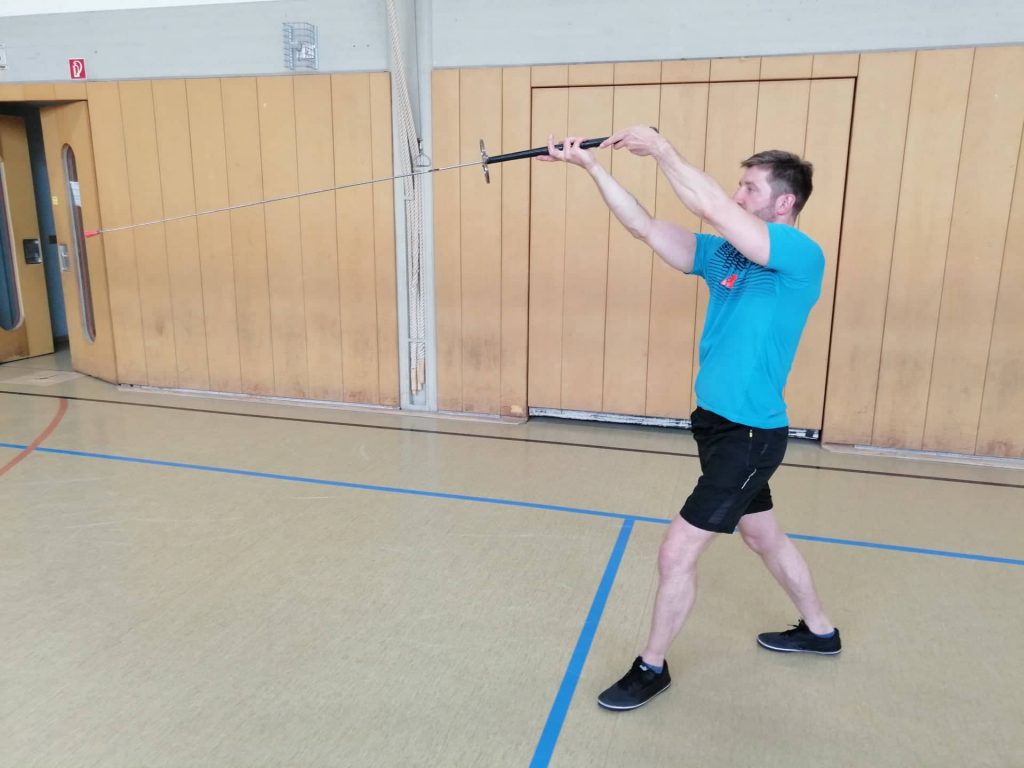
So, considering Marozzo it has been ten years of work on big to very big swords. And today? Do you have a HEMA club and run weekly lessons with students and do seminars abroad? In general, how do you manage your activities related to montante?
“Indeed, my first steps with Marozzo and Figueyredo started ten years ago… I am afraid I’m getting old. 😉
Yes, when I left Kassel, where I ran the first regular montante class in Germany from 2014 until 2017, I was lucky to find a small but good HEMA Club here in Bonn. The Bonn school for martial arts was so kind to give me the opportunity to hold a weekly montante class. Since we are just a small club, our montante group is quite small, just a handful of people.
Besides montante, we train the other Iberian stuff which is related to combat in outnumbered situations. In particular, this are Luis Godinho’s double swords and Miguel Perez de Mendoza’s mangual, the three-headed flail. In addition, we are working with some Italian spadone from time to time. Like Giaccomo Di Grassi, Francesco Alfieri and Pietro Monte. More time is consumed by research, translation of the Spanish texts into German, interpretation work and so on.
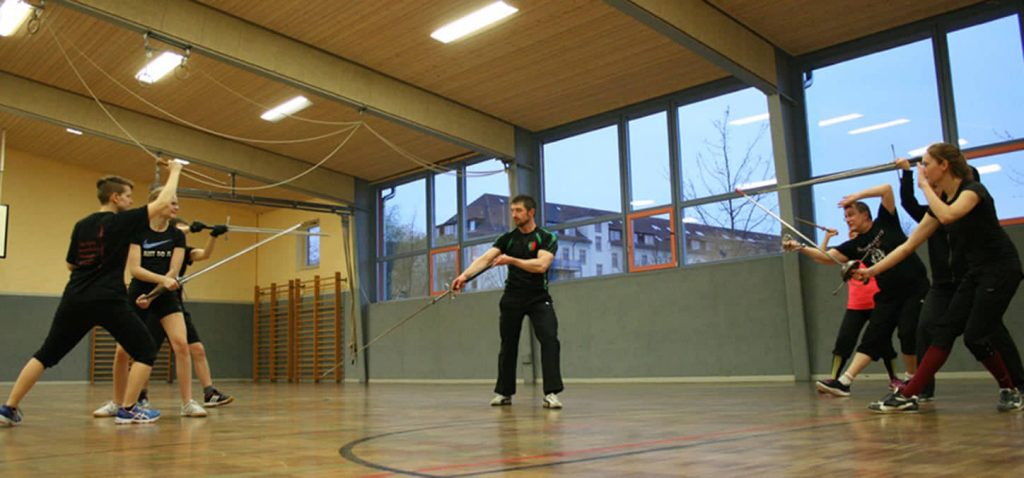
Since we’ve been the only club here in Germany who provided a regular training for montante for a long time, I am traveling a lot to give workshops and classes on HEMA events. To be honest, I had a very tight event schedule during the last years. And in 2018 I’ve been given the honor to give my first class on an event abroad, at the honorable Dreynevent in Vienna. So I am happy that during the last one or two years some other HEMA clubs founded their own regular montante classes here. More people for exchange are always welcome! Of course, managing such a time consuming hobby is not always that easy. Since I got a new job assignment in Koblenz, I am commuting and do not have much spare time. Currently I am pausing my Liechtenauer training and solely are focusing on montante and related topics.”
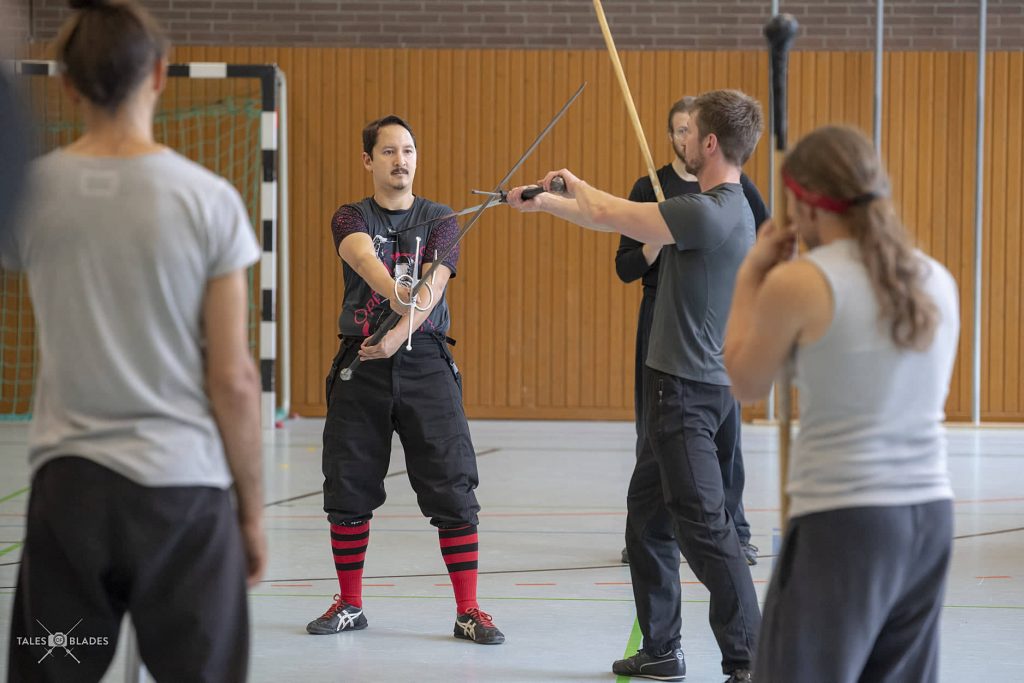
Wow, you have been that busy, I am happy to hear you are so involved despite montante being niche. Spread the verb! But let’s open a short digression before we continue with more about you.
During my talk with Ton Puey (the interview here) a fact was stated: the majority of fencing sources about multiple fighting has Iberic origin with montante, while Italian ones come second with spadone and what you say about the source you have been studying since the beginning seems to confirm it. The impression is that German territories are like the elephant in the room: great and wide medieval tradition with Leichtenauer and friends for what concern the little sister, the longsword; then many others Renaissance treatises among which Meyer, Mair or Codex Goliath; at last the really huge and worldwide known archetype of the Landsknecht Doppelsöldner with his big two handed sword (something witnessed by so many iconographic sources with no equal). How is it possible that with such a background today we have no German material comparable to the Italian or Iberian ones? Do you have any theory or personal opinion about it?
“That’s a very broad and interesting topic, I will give my best to put it in short words.
Let’s start with a short look where the whole story started. May be the birth of the real two-handers, as a descendant from the ‘normal’ longswords, happened somewhere on the melting pot of northern Italy battlefields with its multinational mercenary armies at the late 15th century. Niccolò, it was your own blog which showed us many valuable sources which described the tactical use of two-handers/spadoni on the battlefield and its role in a mercenary formation. Its tactical application often was closely connected to the halberds and it was used for the dirty ‘hack and slash’ when the lines of the formations started to collapse, or similar. So, the early two-hander fencing books of that time still teaches a one versus one combat.
The number of two-handers in military formation and it’s military importance decreased during the next decades of the 16th and 17th century, as we can see by the sources you posted at your own blog during the last couple of months. The two-hander fencing books from the second half of the 16th century onwards describes a ‘specialised’ fencing style against many opponents at once (like Godinho, Figueyredo and Alfieri). Very often this fencing books describes semi-civil scenarios like defending a woman, protecting you coat, or what to do when you leave home at night. The military context becomes much less dominant.
But now, let’s look at the German speaking area Schlachtschwert: we have just two short mentions in German fencing books. Andre Paurenfeyndt from 1516 states that it was used similar to a normal longsword. The second one, Joachim Mayer gives us a ‘chasing’ in the Dussak chapter of his 1560 manuscript and wrote that it would be good as well for ‘a strong guy with a Schlachtschwert’. Besides his dussack chapter, other chasings are described by Meyer in his staff weapon and halberd (!) chapter, in 1570. All the chasings are flourishes similar to Iberian reglas, but always straight forward against a single opponent! Even the polish author Stanislaw Sarnicki wrote around 1580 about german Schlachtschwerter that they are meant to chase away the enemy from battlefield and are used in a cross-cutting wise while not swinging them from too wide nor from too high.
In addition, german Schlachtschwerter as an object have a noticeably different design, compared to their southern counterparts. While montantes and spadoni both are very close to the well-known 3:1 blade:hilt ratio, the heavy German and Swiss schlachtschwerter are always close to 2.5:1. This has a big influence on the way you can handle them. The quite long handle puts them even a step closer to the staff weapons.
Even from secondary German sources I haven’t found any hint that in Germany the Schlachtschwert developed to a special ‘crowd-control/one against many’ weapon at any point of time. Instead, the Schlachtschwert stayed closely connected to mercenaries and battlefields. Maybe it is for this reason why we don’t find any specialised one-against-many-Schlachtschwert-fencing-books in German language.”
Interesting theory. So, perhaps, Germans never really brought these swords from battlefield to time-of-peace contexts. Going by memory, I can agree that non-fencing Italian sources never account German fighting situation having place outside of a battle, even though it is reported their habit to defend flags as well. Perhaps a bit of outnumbered techniques should have been there even on the field. We should check German laws: documents of this kind sometimes help understanding the diffusion and use of weapons according to their prohibitions. Did you have the chance to consult papers of this kind in the past? Or perhaps do you have the title of a good book that expose this topic related to German territories?
“Of course you are right, outnumbered combat even could occur to a mercenary with his Schlachtschwert, too. Even the longsword chapters of the MS 3227a from 1389 describes at least a short passage for fighting ‘against 4 or 6 people, from the iron port guard’ using a technique called ‘peacock’s tail’ and with rising cuts (and on the other hand, we have a picture in the 2º MS Math.7 tournament book from around 1630 with two guys in full harness at a tournament 1 vs 1 with heavy Schlachtschwerter…). But the point is, this is not a special weapon meant for exactly that purpose, like it is the case of montante.
A lot of research still has to be done into this topic. Personally I didn’t do any research for judicial texts, but I agree it should be done. By now, I don’t know of any mention of a Schlachtschwert in this context.”
Yeah, we should delve into German old books and documents, I am sure there is a treasure hidden. In the future, perhaps…
But shifting the topic a bit, what about the German nomenclature? Many people like to call this kind of sword Zweihänder. Today this is actually an archetype name but, honestly, even if I didn’t spend too much time on German sources – due to linguistic difficulties – I did not find any XVI or XVII century document using this term, while Schlachtschwert is found many times. Bidenhänder, Bihänder, Beidenhänder and Gassenhauer are four more name I came across on Internet but I think that some of them are just modern words, while I am a bit confused by the actual meaning of Schwert and Langenschwert related to treatises swords (did they just mean “sword” during that time?). Can you give us your two cents about all this German terminology?
“Actually, the most frequently used name in modern German today is Bidenhänder. This is a more modern term, which is true for most of the nomenclature concerning swords. I agree with you, the correct contemporary name for the big swords is Schlachtschwert (‘battle sword’, or it could even be translated as ‘slaughter sword’ ). During the time of the sword fencing books they often tend to call ‘sword’ just everything.
In the fencing treaties (especially the early ones) Langes Schwert (long sword) refers to the way of using it – with two hands at the hilt. While Langschwert is a modern term which refers to any one handed sword with a long blade, a spatha for example could be named a Langschwert. To make the confusion even greater, lately people tend to say just Langschwert instead of Langes Schwert because it is shorter and easier to say.
In contrast to this, fencing im kurzen Schwerter (in the short sword) or kurzes Schwert zu Kampf (short sword to combat [in harness]) is with one hand at the hilt, and the left hand placed in the middle of the blade. Today we very often hear the wrong name Halbschwert (halfsword), which is a misunderstanding of a passage from Sigmund Ringecks’ fencing book where he tells us to put our left hand at the half sword. During that time halb (half) could have the meaning of ‘middle part’. So if you place your hand at the half of your sword, you fight in the ‘short sword’ combat style.
One handed swords have been very rare during the time (15th century) in Germany, they used the Messer instead. So one handed swords have been kind of ‘reintroduced’ in the middle of the 16th century, coming from foreign countries. For this reason, sideswords and later the rapier were not called ‘sword’, but rapier. So a sword during that time usually was some kind of two handed.”
Ok, this makes it more clear to me, I hope so for others as well.
Now let’s leave Germany to return to the material you have been facing recently: you study Spanish Master Luis Díaz de Viedma’s treatise (1639). Quite certainly he is even less known then Alfieri and he does not spend too much words about montante; in fact he makes no mystery about considering it a not noble weapon and he gives us just three exercises to train it. I consider his point of view interesting and some of his words are useful to collect hints for a historical context reconstruction (like the rarity of the weapon at that time or the disrespectful way it was used for defense), but honestly I haven’t spent much time on Viedma, even though you ran a seminar about him during International Montante Symposium 2018. I was challenged by your exercises and my brain was melting due to some interesting body mechanics and composed drills. Tell us something about your experience with this treatise: challenges, curiosities, pros, cons… Feel free, Viedma is quite an uncharted land and every tip can reveal as useful.
“Well, Viedma says that montante is not very common during his time and not polite, but he seems to hold it in high regard when it comes to life or death and you don’t need to worry about collateral damage.Short treatises like Viedma’s always brings a special challenge for their interpretation. Because there is not much material, it is hard to understand what is the author’s intention for his martial system. Usually I kind of integrate these reglas into an other, better known system. This becomes important, in particular if working with sources which are just short notes, like Paredes or the anonymous 1563. In this case I try to do the reglas according to the basic principles and style of Luis Godinho’s system – Godinho has always been the core source of my montante interpretations. But Viedma is a bit different here. He just has three reglas, but he describes them with many, detailed words, and in addition he has a whole book of his rapier system, which helps a lot for understanding his way of thinking. So I finally got to my interpretation of his montante chapter after cross checking, correlating passages from his introduction, his closing words and his rapier chapters. But still, it is heavily influenced by Godinho and my personal interpretation of it.
So it is funny to hear you found the mechanics challenging – you’re not the first one saying that ^^ Maybe this special ‘twirling around’ comes from my Godinho point of view I took for my approach into the Viedma topic.”
Well, this is for sure, the next time we will meet, I will ask you to show it to me again. That twirling on the place was too awesome to watch.
So, staying on montante topic, but changing perspective: some time ago I found out you are the first customer who asked Peter Regenyei to smith what is today known as Montante no. 4, one of its longest though lightest two handed swords available. Light weight is always one of the most meaningful specifics for a two handed sword and my impression is that this particular model is having good fortune among those who practice; I ordered a custom spadone based on its blade as well. Would you like to tell us the story behind it? Why did you choose Regenyei for this kind of work, what did you want to achieve and what was the meaning behind its design choices (length of the handle, cross section of the blade and so on)?
“After some time of studying montante, around 2012, I felt it was time to get a steel sword made especially for montante training. But all swords available were too short, too heavy or both of them. Than I got an advice from Alex from Fior della Spada, his club in Vienna just got two really good spadone trainers from Peter Regenyei for their Marozzo spadone training.
I made two wooden prototypes for trying around with the dimensions. I tried out at which blade length I started hitting the floor too often. The length of the handle was intentionally chosen a bit on the long side, because with a too long handle you still can put your hands closer together, which is not possible the other way round. The parrying hooks, crossguard and side rings were measured to provide a wide range of possible ways of holding the weapon. The rest of the design details should be made according to the historical specimens and following the premise of light weight and low costs. Finally, I wrote an email with my ideas to Peter Regenyei and attached a measured hand drawing and several museum pictures from some Spanish and even one or two Italian greatswords.
And I am absolutely pleased with this great work he did. I think his Montante no. 4 is still the most widespread sword among European HEMA montanteros and montanteras. But I have to say his newer Spadone No. 3 is very good, too. Only a little bit on the short side. I’d like to know who designed it?
Of course, after using my montante no. 4 for a lot of years now, I recognized at least one point that could be done better. I heard a lot of people during the last few years complaining about the handle being too long – which is true. Some say it should be a third of the length of the blade – which is only partly correct, if you go by the advice from Pacheco’s treatise. The part of the quotation that is often forgotten here is that the sword itself should be as tall as a man, and the handle a quarter of it. So, you can’t apply this proportions to a sword which is significantly shorter than yourself.
Finally, this summer I shortened the handle of my no. 4 by 6 cm, which improved the handling a bit. Thanks here for the helpful advice from Lukas Maestle-Goer from the Schwabenfedern in Ulm, he is a great swordsmith, indeed.”
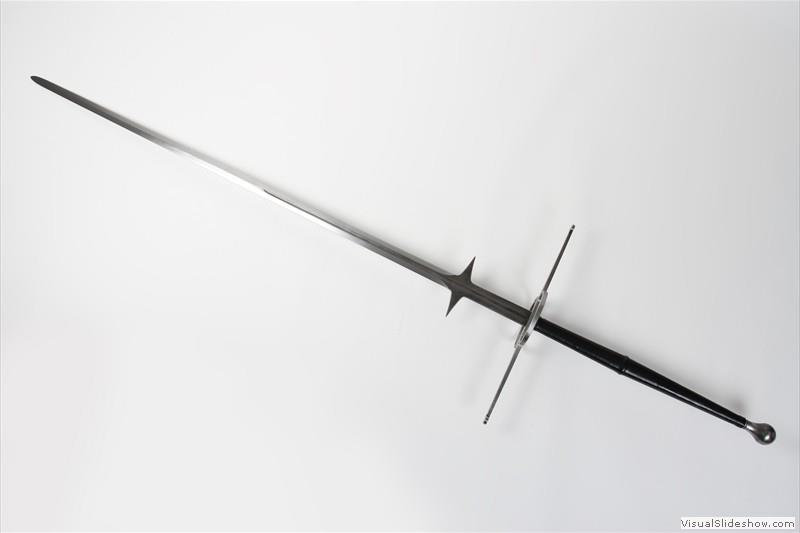
Yeah, you both did a good job together, my new customized one is excellent. So you have a special concern about the tool stats. I happened to read posts where you complained about the lack of actual good big swords exceeding a certain length. I can confirm that good two handed swords longer than 165 cm more or less with good weight are rare and tall people like us (I am 191 cm) can’t experiment the weapon for what is described exactly in some sources. In this regard, more in general, how do you value the different tools one can profit from when practicing montante? (stick, mangual, nylon trainer, Federschwert and so on…)
“Thanks, but I am pretty sure Peter Regenyei’s part in this work has been much bigger than mine. Of course, the best tool for practicing would be a real, sharp montante you have stolen from a museum. But I don’t recommend this for other reasons… So, a good, blunt steel trainer is still the best solution for most cases.
Indeed I faced the problem of finding a proper sized one. While a shorter one is a very good solution for beginners, an advanced montantero should have a realistic sized steel trainer (almost) as tall as oneself. I was searching for a very long time and finally I ordered a sword in UK. I hope it will arrive before Brexit comes true. Please, press thumbs!
But the synthetics works really good for montante, too! The biggest drawback of synthetics is their behaviour during binding actions. Especially the very long blades tend to bounce off each other. However, the good point when being a montantero is, actions from the bind are not important for your training! Therefore, a cheap nylon is a great training tool, especially but not limited to beginners. In addition, it is much safer. You know, for our tournaments and free fight training we use synthetics with simple added padding from pipe insulation foam. They still hit hard as a truck, but they are the best compromise so far. It’s a pity that the usual synthetics are only 1.58 m, that’s way too short for people like you, and even for me.
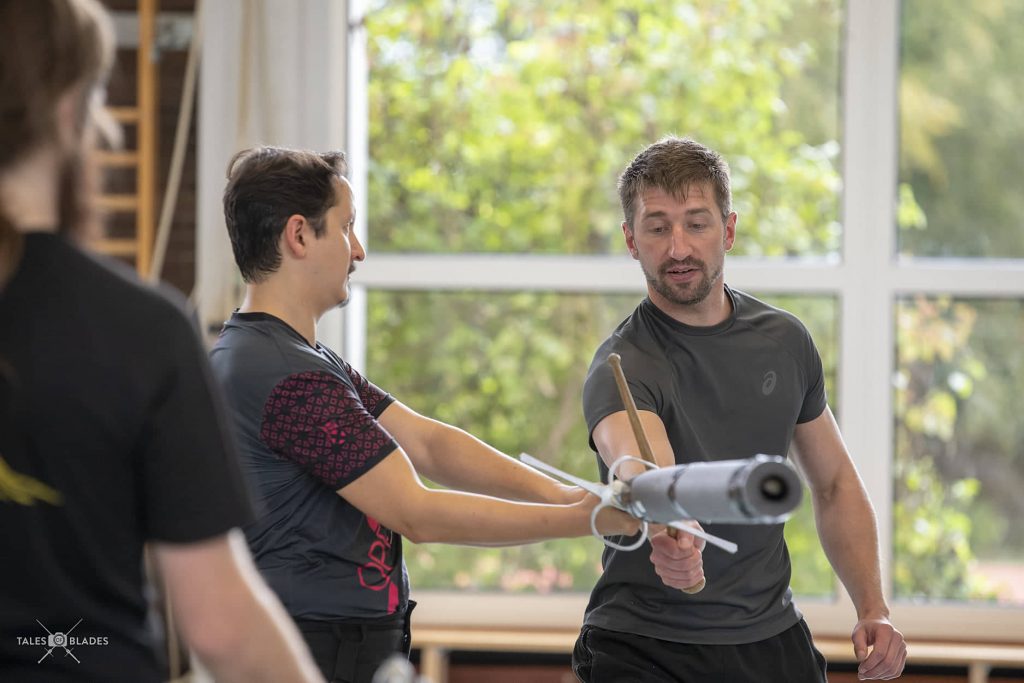
Which brings me to the next point – currently I am working together with Paul Becker from the In Motu fencing school on the development of a special padded montante waster, which would be a bit longer. It will be safer than the nylon with the afterwards added padding – and much cheaper, too. I hope the prototype will arrive during the next weeks.
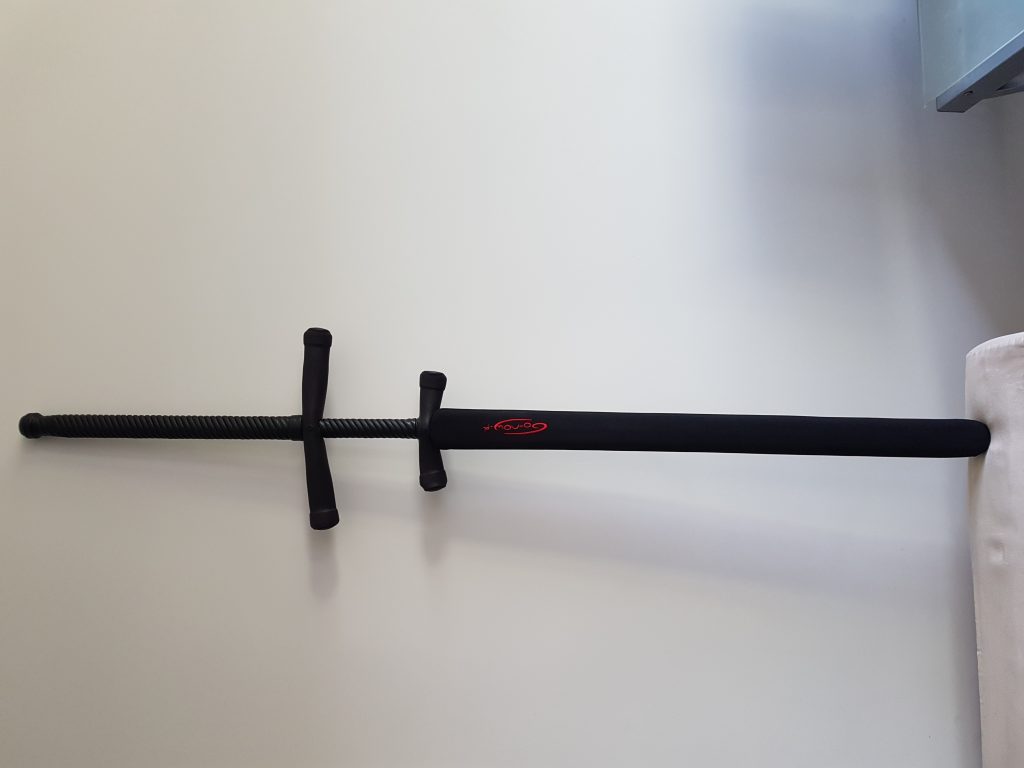
Some words to other training substitutes: many beginners start with just using their normal longsword or Feder. I recommend this only if you have a very big longsword of at least more than 1.40 m. I myself am quite average tall at 1.83 m, and I have a big longsword (1.41 m, 2.05 kg), and it may work for montante. But if you have a shorter sword, than a simple broomstick of 1.7 m would do a much better job for training.
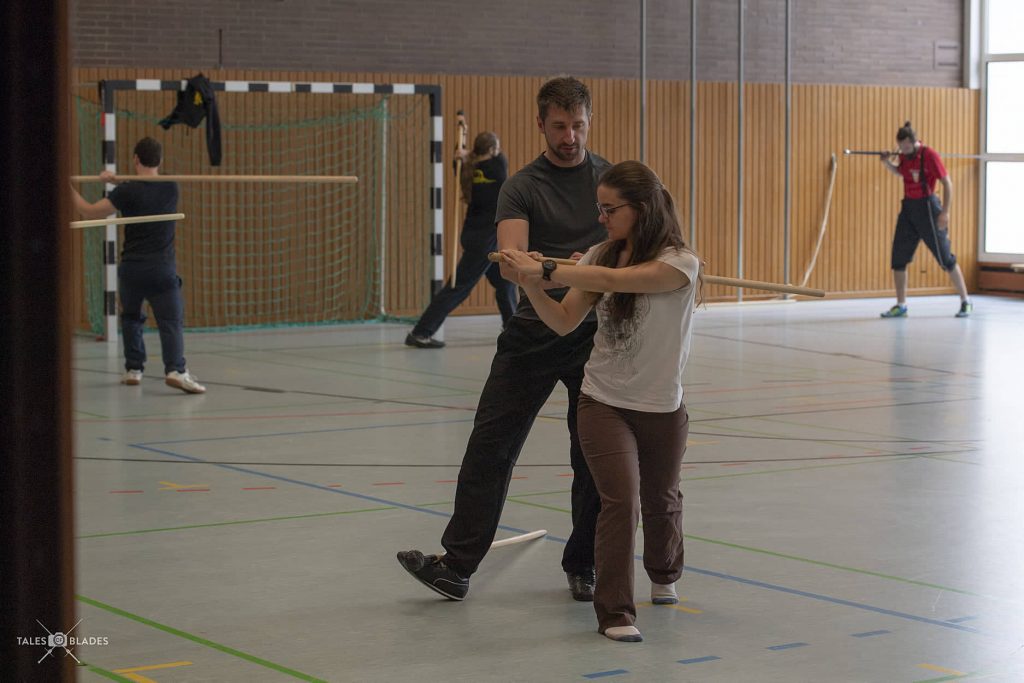
You mentioned the mangual, too. Of course this is such a great training tool, I just love this completely insane weapon! You can build your own from quite cheap material, and you can learn a lot from this tool. Because of its chains, you will be forced to use smooth, round motions and to learn to move with your weapon, not against it. However, I recommend this as an additional tool for people which are already used to some of the fundamentals of handling of montante.”
And speaking about nylon, you are the mind behind the Experimental Tournament which challenged us during the 2018 International Montante Symposium (IMS) in Bielefeld. The experience was great fun with a massive dose of adrenaline. It is a kind of fight so uncommon for a hemaist because one must face more enemies from different directions: just crazy rampage. Tell us shortly what is it and about the rules and then something about its development and the principles that lead you its final rules set.
“The idea was born because of many people complained that you cannot do competitive fighting with a montante. A montante is too heavy and dangerous, and the techniques are not suitable for competitive one-on-one combat. So I thought well, it does not make sense to make a one-on-one tournament with a montante, you need a special one-versus-many competitive mode – with a safe, padded montante-waster. I got the inspiration for the padded waster when I visited Emil and Baz in Malmö. We already did scenario training in my own club during that time.
The only thing still missing was some way of evaluating the fight, a way of counting points. However, we wanted to reflect the special intention of the art of montante. We let a montantero fight against a group of enemies equipped with one-handed weapons. The montantero has 2 ‘hit points’ while the enemies are out of the game by their first hit by the montante – this should reflect that a montante has more stopping power than the lighter weapons. Montante is more about keeping the crowd at distance than about killing everyone. The montantero wins with 10 points if he survives unharmed, 5 points if surviving while being hit one time. For every enemy he hits, he gets ‘only’ one additional point.
To prevent the enemies from just waiting until the montantero get exhausted, we placed a time limit of 2 minutes. On the other hand, it is important to prevent the surrounding enemies from just suicide rushing the montantero, so they get one point for surviving and one point if hitting the montantero. We discussed to give an additional point for all surviving enemies if they managed to defeat the montantero, but we dropped this for the first tournament to keep it simple. At least for our first trial run 2018.
After the fight, the montantero passes over his montante to one of the enemies who becomes the montantero for the next fight. After everyone has had their turn, you count the points – that’s it.
This tournament system still is not perfect, but as you know, it already is great fun and a great show to watch! We have got a lot of new ideas for the next tournament, thanks to the wide range of feedback from the last one. This way of counting points can be applied to all the scenarios we know from the sources, not just the ‘surviving for a certain time’. Other modes like ‘breakthrough to exit’, ‘defend your coat’, ‘protect a lady’, ‘kill the rodoleros’, ‘escape from a street’ or ‘cross the parcours’ are possible.”
This experiment suggests the need to bring montante to a more complete approach: longsword, like many other weapons, has its practice as well as its competitions, while big swords are still confined inside a niche made mostly of solo drills and “unappealing” patient practice. I must confess that in January 2018, while I was managing with my club mates the first edition of Totentanz Tournament (an Italian team tournament for multiple weapons), I had the idea for a team-like competition for montante, like a sort of baseball league with stations on a field composed by different terrains, to be conquered by a montantero against many adversaries and I called it MontantHero Bout. Now, that was just an idea never gone further than its name and concept, but when I read about your IMS competition some months after I thought you were probably setting a first step for something similar. I had a lot of talk about this with Meik of Drey Wunder, when he hosted me at his home in Bielefeld, I hope to have provided some contribution. What is your opinion about this topic: big swords, leaving the drill zone and finding new future competition formats never seen before in HEMA?
“Competitions are a tricky topic for me, personally. For me, it is an important part of HEMA that competitive fighting should be an integral, but subordinated part of it. If competitions becomes your main goal and focus, you start to lose your ‘H’ in HEMA. This by itself is not a bad thing, but that’s not what I am looking for personally. On the other hand, a competitive environment gives you at least a glimpse of realistic, stressful, non-cooperative environment you can hardly simulate without such a competition – or without serious injuries – during your training routine. Therefore, competitions and tournaments are an important part but it is important to find the right balance of art and sport for yourself. In addition, tournaments with montante are great, great fun!
I like the Idea of MontantHero you described, it fits perfectly to the spirit of the montante and would be a lot of fun. It reminds me of Figueiredo’s closing words: «One who is well exercised in them could never find strange the place of the fight or the opposing arms, or even less the number of adversaries». It seems to be quite similar to the ‘cross the parcours’ mode I mentioned above. The sources by itself gives us the spots for such a MontantHero-parcours: wide, narrow and intermediate streets, crossroads, squares, galley gangways, doors, bridges… I am sure tournaments like these would be a big boost for the montante scene, because they are different and it is a very varied sport. Maybe this could even be attractive for an audience – maybe more fun to watch than a longsword tournament.
However, we need proper equipment for this. As I can tell from my own experience, a hit from a 1.6 m sword can knock you out! I hope that the foam-padded waster currently under development will be a step forward here.
However, we should definitely take this step and show the community that montante is an art you can apply in tournaments and championships as well as in self-defence.”
I can agree, I can’t wait for a next more challenging ride! To conclude our conversation, as you say that there is still something to show: how do you see spadone, montante and big swords in general in today HEMA panorama? Underrated or not? Do you see a rising curiosity as Ton Puey says? Is there anything we can do, apart from increasing competitions, to boost interest around this weapons?
“I totally agree with Ton. Montante fencing is at a point where it starts to become more popular, or at least where its renown is spreading. I just can speak for Germany here, where longsword is the all dominating branch in HEMA – no surprise for the birth country of Johannes Liechtenauer. When I held my very first classes on montante years ago, I had to explain every time what a montante is at all – and that such a thing like fencing against many exists. Luckily that’s not necessary any more. Likewise, the number of groups dealing with montante is slowly increasing. But I am sure it will never reach the numbers of the longsword or even the number of active rapier fencers in Germany. The ‘fighting against many’ style is too special here. And even if we succeed in establishing montante competitions, it would hardly be compatible with the fencing-Feder-duel-focussed tournament scenery which is gaining importance.
So what can we do to boost interest in it? We just have to inform the people. I made the experience that most people get interested after they have seen the beauty of this art, because they have always imagined it in a completely different way.
I remember a weekend in 2013 when one of my first montante courses took place at the Tremonia Fechtschule in Dortmund. The evening before my workshop we sat around the campfire, and I asked the HEMA people around which workshop they would have attended the next day. Maybe 5 of them told me they want to visit the montante class, about 20 wanted to visit the Messer class. The talking at the bonfire went on and I tried to explain a lot what montante really is. The next day a whole crowd of people ran around the building looking for some tool or staff they could use for montante training. The numbers swapped, 15 or 20 people participated the montante workshop. One guy even had stolen a retractable scrubbing brush handle from the basement to use it as a montante substitute. I still have the pictures of it. I just felt sorry for the trainer of the Messer class.”
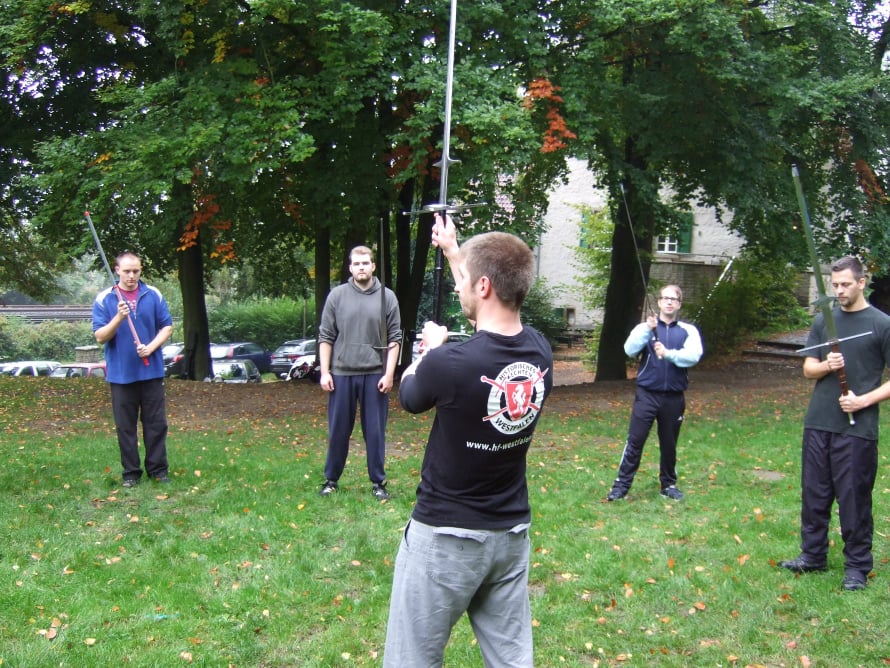
Immensely funny story, I feel sorry for that guy myself ahah, thank you for your time Jan, I am sure this interview provides good material for the readers. Hope to see you in the future.
“Thank you very much for asking me, Niccolò! In addition, let me say thank you for your invaluable work you are doing with your Spadone Project. Your articles and postings have been an invaluable source of knowledge to me during the past year. Go on with it! It’s one of many steps to inspire people to pick up montante. I hope to see you soon at the next big montante event, too. Be it a workshop, a tournament or a lecture.”
To all the readers: we will meet for the next interview, don’t loose it!

